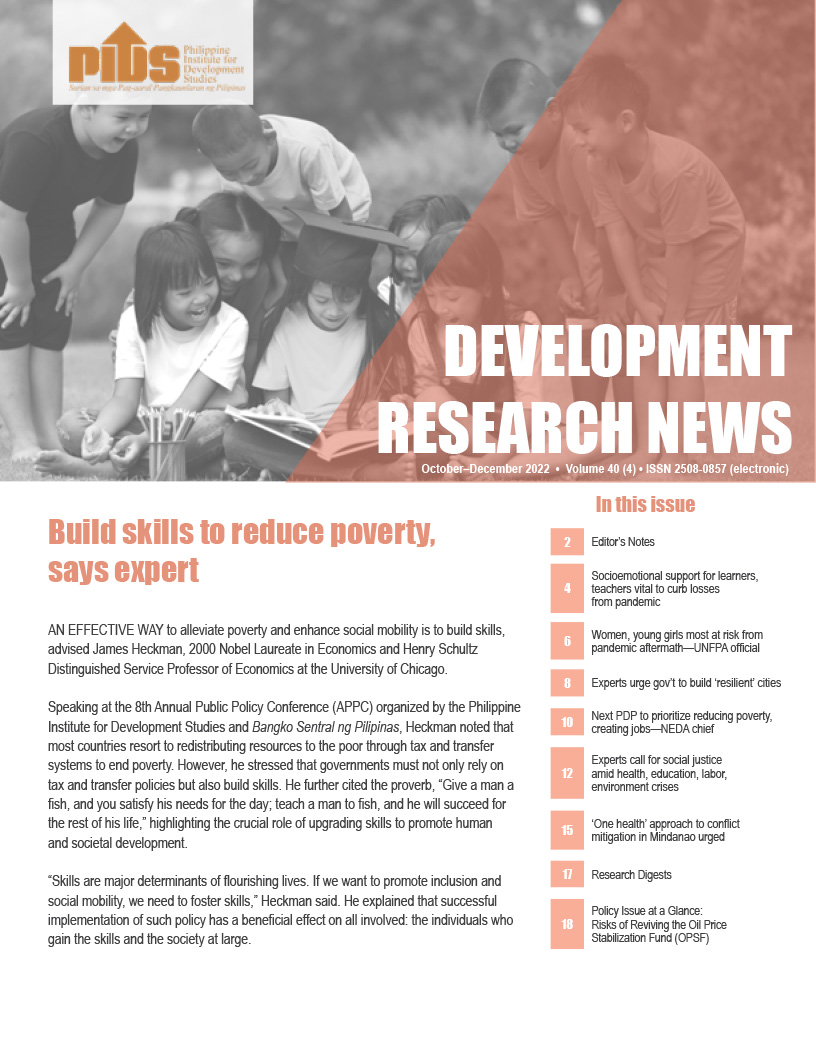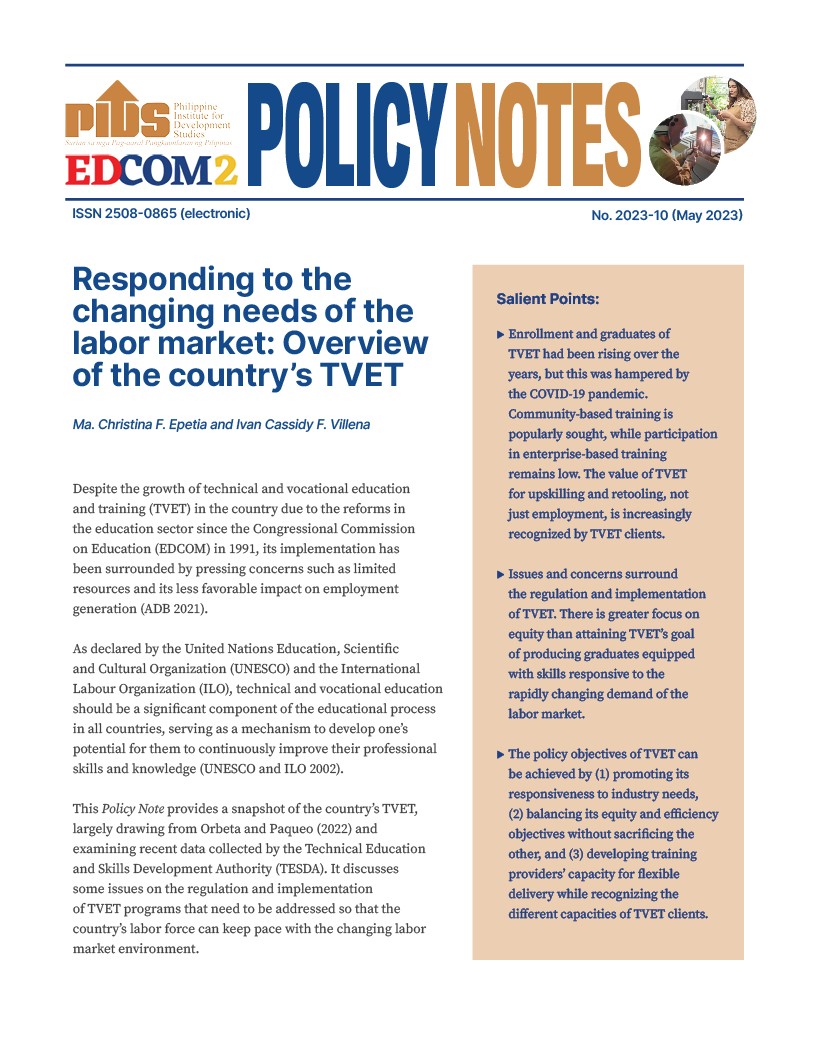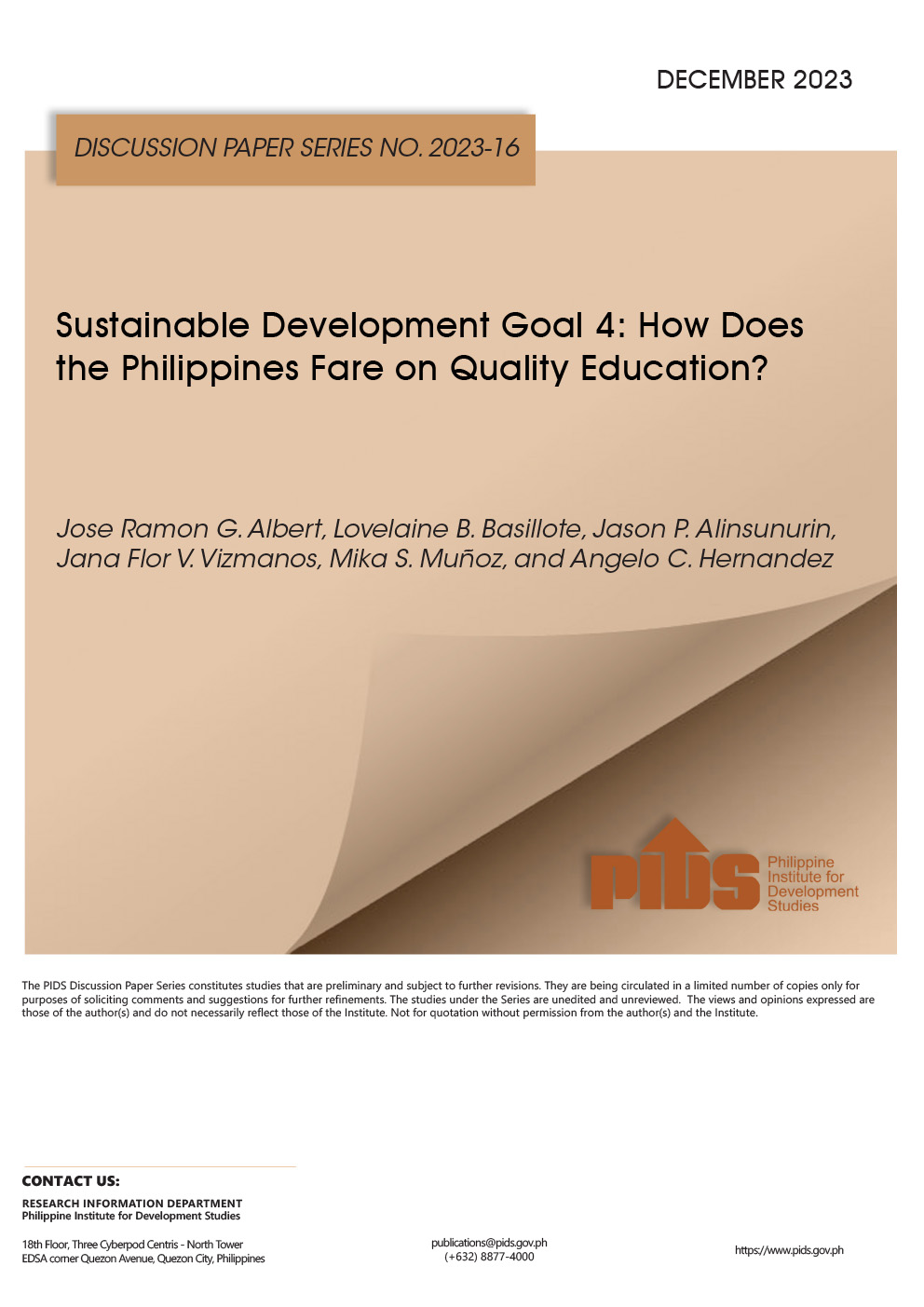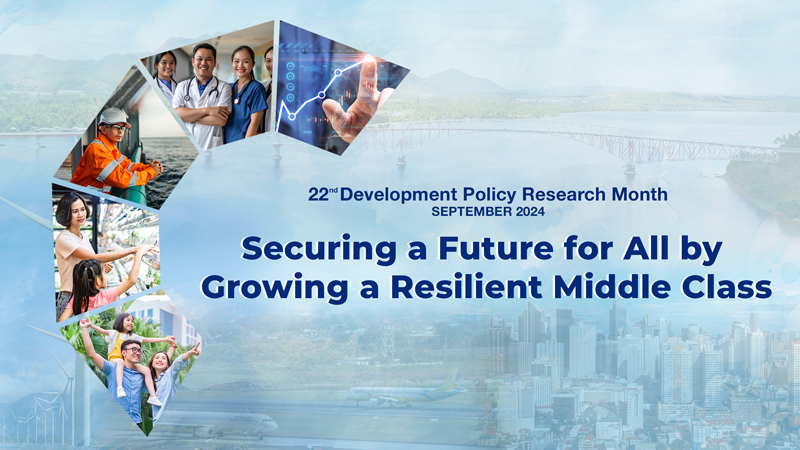An aggressive isolation of COVID-19 carriers must be put in place after the one-and-a-half months of enhanced community quarantine enforced in Luzon and most parts of the country to avoid infecting as many as 8.7 million Filipinos, a report of the state-run think tank Philippine Institute for Development Studies (PIDS) showed.
In a paper, PIDS said at least 70 percent of carriers must be isolated “to supress the outbreak.”
This should be done through “better contact tracing, social distancing, individual or household isolation, and reduced delays in time to seek care for symptomatic cases,” said the paper, “Projected Disease Transmission, Health System Requirements, and Macroeconomic Impacts of the Coronavirus Disease 2019 (COVID-19) in the Philippines”.
If this wasn’t done, the PIDS said, lifting lockdowns “but maintaining current conditions of delayed time to seek care for symptomatic cases merely delays the progression of the outbreak but still results in around 8 percent of the population infected.”
The Philippines’ population stood at almost 108.8 million as of 2019, based on the latest Philippine Statistics Authority (PSA) data.
A bigger COVID-19 outbreak will make it more difficult for the country’s health care facilities to respond.
“For all scenarios that do not successfully isolate at least 70 percent of infectious individuals, demands for health care resources generated by COVID-19 at the peak of the outbreak far exceed available supply in the health sector,” said the paper authored by Michael Abrigo, Jhanna Uy, Nel Jason Haw, Valerie Gilbert Ulep and Kris Francisco-Abrigo.
“For example, assuming no further improvements in the ability to isolate symptomatic cases post-enhanced community quarantine, the country’s health system would require 1.51 million beds, 456 thousand ICU beds, 246 thousand ventilators, 727 thousand doctors, a million nurses, 91 thousand medical specialists, and 36 million PPE [personal protective equipment] sets on the peak day of the outbreak in August 2020,” the paper read.
Across several scenarios assuming various types of interventions ranging from no intervention or a status quo to aggressive post-quarantine strategies, the PIDS paper’s projected total COVID-19 cases ranged between 904,000 and 18.9 million, with cumulative deaths of 399,000 to 1.66 million.
In the best case scenario of isolating 70 percent of symptomatic cases even if the government would partially lift the lockdown, COVID-19 infection could peak as early as May or June, the paper’s projections showed.
“Extending the enhanced community quarantine without other mitigation measures merely delays the progression of the outbreak and still results in a large number of cases,” it said.
“Aggressive efforts to implement early testing and, more importantly, earlier isolation of the majority of symptomatic cases to prevent them from infecting other susceptible individuals will be crucial to suppress the outbreak,” it said.
According to the PIDS paper: “The enhanced community quaranti
ne may have provided the health system some time to prepare but in itself not sufficient to contain the outbreak. In the absence of more aggressive public health interventions, a successive wave of infections could rise months after the enhanced community quarantine.”
As such, “the government should not be complacent, and should be strategic in containing the outbreak,” the paper said.
The PIDS said that both the health and economic risks from COVID-19 can be contained through “a gradual and calibrated transition to a risk-based strategy that combines relaxation of economic restriction while controlling the spread of the virus.”
“As the economy reopens, the government should continuously expand its capacity to perform the following: detect and isolate individual cases, and identify close contacts; protect high risk population groups, including healthcare workers; continuously implement public health measures, such as physical distancing and handwashing; and treat many patients as possible, particularly severe and critical cases,” it said.
“To implement these requires a whole-of-government approach,” PIDS said. “The general strategy should not be hospital centric.”
“Efforts to control the transmission of the virus should start in local communities, and hospitals shall serve as the last line of defense,” it said.
“The role of local governments to implement public health programs and surveillance are (sic) critical,” it added.
The paper sought to scale up testing capacity as well as contact tracing; decongesting health facilities by expanding isolation and quarantine facilities outside of hospitals for mild cases or suspected cases presenting with mild symptoms, with the help of local governments; providing “a more humane approach for enforcing quarantine and isolation for suspected and confirmed cases” of COVID-19; giving a wider range of protection and support to health workers; and removing all bottlenecks on PPE production and importation.
“The goal of the government should not be solely confined to ‘flattening’ the epidemic curve, but also to limit prolonged disruptions in the economy” by deploying massive safety nets to ensure continuous access to food and basic necessities; ensuring continuous and unencumbered supply chain flow; and “revitalizing economic activity without endangering public safety” through measures allowing production of goods and services as long as with strict physical distancing controls.
PIDS projections showed that the COVID-19 pandemic would shed a minimum of P276.3 billion and a maximum of P2.5 trillion from the Philippines’ gross domestic product (GDP), which stood at about P14 trillion.
“The transport, storage, and communication sector is expected to suffer substantial losses because of expected declines in tourism (P11.7-124.3 billion),” it said.
“Other services (P41.5-356.9 billion), manufacturing (P82.1-855.2 billion), and wholesale and retail trade (P93.2-724.8 billion) are projected to be substantially negatively affected by weaker global and domestic demand,” the paper’s abstract read.
Also, lockdowns to contain the disease would ultimately directly impact on employment—“household and community interventions (such as self-isolation and community quarantines) may induce greater exit from the workforce,” the paper said.
For the PIDS, extending community-wide quarantines may increase these economic losses given the same non-medical mitigation measure implemented,” citing its projections showing that “extending the enhanced community quarantine by one more month may potentially cost the Philippine economy at least P150 billion due to possible declines in household consumption as workers remain unemployed for longer periods.”
“The cost of inaction may be larger, however. In a no-intervention scenario, the Philippines may lose about P2 trillion in foregone gross value added as a result of weaker household demand as more workers are unemployed for extended periods of time,” it said.
In a paper, PIDS said at least 70 percent of carriers must be isolated “to supress the outbreak.”
This should be done through “better contact tracing, social distancing, individual or household isolation, and reduced delays in time to seek care for symptomatic cases,” said the paper, “Projected Disease Transmission, Health System Requirements, and Macroeconomic Impacts of the Coronavirus Disease 2019 (COVID-19) in the Philippines”.
If this wasn’t done, the PIDS said, lifting lockdowns “but maintaining current conditions of delayed time to seek care for symptomatic cases merely delays the progression of the outbreak but still results in around 8 percent of the population infected.”
The Philippines’ population stood at almost 108.8 million as of 2019, based on the latest Philippine Statistics Authority (PSA) data.
A bigger COVID-19 outbreak will make it more difficult for the country’s health care facilities to respond.
“For all scenarios that do not successfully isolate at least 70 percent of infectious individuals, demands for health care resources generated by COVID-19 at the peak of the outbreak far exceed available supply in the health sector,” said the paper authored by Michael Abrigo, Jhanna Uy, Nel Jason Haw, Valerie Gilbert Ulep and Kris Francisco-Abrigo.
“For example, assuming no further improvements in the ability to isolate symptomatic cases post-enhanced community quarantine, the country’s health system would require 1.51 million beds, 456 thousand ICU beds, 246 thousand ventilators, 727 thousand doctors, a million nurses, 91 thousand medical specialists, and 36 million PPE [personal protective equipment] sets on the peak day of the outbreak in August 2020,” the paper read.
Across several scenarios assuming various types of interventions ranging from no intervention or a status quo to aggressive post-quarantine strategies, the PIDS paper’s projected total COVID-19 cases ranged between 904,000 and 18.9 million, with cumulative deaths of 399,000 to 1.66 million.
In the best case scenario of isolating 70 percent of symptomatic cases even if the government would partially lift the lockdown, COVID-19 infection could peak as early as May or June, the paper’s projections showed.
“Extending the enhanced community quarantine without other mitigation measures merely delays the progression of the outbreak and still results in a large number of cases,” it said.
“Aggressive efforts to implement early testing and, more importantly, earlier isolation of the majority of symptomatic cases to prevent them from infecting other susceptible individuals will be crucial to suppress the outbreak,” it said.
According to the PIDS paper: “The enhanced community quaranti
ne may have provided the health system some time to prepare but in itself not sufficient to contain the outbreak. In the absence of more aggressive public health interventions, a successive wave of infections could rise months after the enhanced community quarantine.”
As such, “the government should not be complacent, and should be strategic in containing the outbreak,” the paper said.
The PIDS said that both the health and economic risks from COVID-19 can be contained through “a gradual and calibrated transition to a risk-based strategy that combines relaxation of economic restriction while controlling the spread of the virus.”
“As the economy reopens, the government should continuously expand its capacity to perform the following: detect and isolate individual cases, and identify close contacts; protect high risk population groups, including healthcare workers; continuously implement public health measures, such as physical distancing and handwashing; and treat many patients as possible, particularly severe and critical cases,” it said.
“To implement these requires a whole-of-government approach,” PIDS said. “The general strategy should not be hospital centric.”
“Efforts to control the transmission of the virus should start in local communities, and hospitals shall serve as the last line of defense,” it said.
“The role of local governments to implement public health programs and surveillance are (sic) critical,” it added.
The paper sought to scale up testing capacity as well as contact tracing; decongesting health facilities by expanding isolation and quarantine facilities outside of hospitals for mild cases or suspected cases presenting with mild symptoms, with the help of local governments; providing “a more humane approach for enforcing quarantine and isolation for suspected and confirmed cases” of COVID-19; giving a wider range of protection and support to health workers; and removing all bottlenecks on PPE production and importation.
“The goal of the government should not be solely confined to ‘flattening’ the epidemic curve, but also to limit prolonged disruptions in the economy” by deploying massive safety nets to ensure continuous access to food and basic necessities; ensuring continuous and unencumbered supply chain flow; and “revitalizing economic activity without endangering public safety” through measures allowing production of goods and services as long as with strict physical distancing controls.
PIDS projections showed that the COVID-19 pandemic would shed a minimum of P276.3 billion and a maximum of P2.5 trillion from the Philippines’ gross domestic product (GDP), which stood at about P14 trillion.
“The transport, storage, and communication sector is expected to suffer substantial losses because of expected declines in tourism (P11.7-124.3 billion),” it said.
“Other services (P41.5-356.9 billion), manufacturing (P82.1-855.2 billion), and wholesale and retail trade (P93.2-724.8 billion) are projected to be substantially negatively affected by weaker global and domestic demand,” the paper’s abstract read.
Also, lockdowns to contain the disease would ultimately directly impact on employment—“household and community interventions (such as self-isolation and community quarantines) may induce greater exit from the workforce,” the paper said.
For the PIDS, extending community-wide quarantines may increase these economic losses given the same non-medical mitigation measure implemented,” citing its projections showing that “extending the enhanced community quarantine by one more month may potentially cost the Philippine economy at least P150 billion due to possible declines in household consumption as workers remain unemployed for longer periods.”
“The cost of inaction may be larger, however. In a no-intervention scenario, the Philippines may lose about P2 trillion in foregone gross value added as a result of weaker household demand as more workers are unemployed for extended periods of time,” it said.









